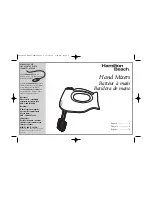
12
Operation
Note: We recommend you not adjust the
GAIN
controls after you have preset the in-
puts as some sound imbalance could occur.
Setting the Sound Balance
BALANCE
lets you adjust the sound balance
between the left and right speakers. If your
speakers are properly positioned and your
listening area is centered between the
speakers, the center setting of the control is
usually the best.
If the sound seems to be louder from one
speaker, adjust
BALANCE
until the sound
seems to be coming from a point midway be-
tween the speakers.
USING A MICROPHONE
Using an XLR Microphone
To mix the microphone connected to the
XLR jack with other audio input sources, ad-
just
DJ MIC LEVEL
to increase or decrease
the microphone volume without affecting the
volume of the other inputs.
Set
DJ MIC LEVEL
to
0
when you are not us-
ing the DJ microphone. Or, if the microphone
has an ON/OFF control, set it to OFF and
leave
DJ MIC LEVEL
at its preset position.
Using an AUX Microphone
To mix a microphone connected to the
AUX
MIC
jack with other audio input sources, set
AUX MIC/LINE
to
MIC
. Adjust
AUX LEVEL
to
increase or decrease the microphone vol-
ume without affecting the volume of the other
inputs.
When you are not using an
AUX
microphone,
set
AUX MIC/LINE
to
LINE
. This lets you mix
the output from the device connected to
AUX
LINE MONO
jacks.
Using TALKOVER
To use the microphone and reduce other au-
dio inputs so the microphone can be heard
more clearly, set
TALKOVER
to
ON
.
To turn off
TALKOVER
, set T
ALKOVER
to
OFF
. All the audio inputs including
DJ MIC
and
AUX MIC
play at the same output level,
and the background music volume is not re-
duced.
Using MUTE LEVEL
To increase background music when using
TALKOVER
, rotate
MUTE LEVEL
toward
MIN
.
To reduce background music, rotate it to-
ward
MAX
.
Using PAN
To play either microphone or the
AUX LINE
output on the left or right channel, adjust the
appropriate
PAN
control. Set it to
L
to play
through the left channel, to
R
to play through
the right channel, or to any other position be-
tween
L
and
R
to play through both channels.
USING SOUND EFFECTS
There are six preprogrammed sound effects
for your mixing selection — a hi-hat close, a
rim shot, a cow bell, a cymbal, a bass drum,
and a laser drum.
To play a sound effect, repeatedly press or
hold down the desired
SOUND EFFECT
but-
ton.
Rotate
SOUND EFFECT LEVEL
left or right to
increase and decrease the sound effect vol-
ume.
USING ECHO EFFECTS
The mixer plays echo effects, and lets you
adjust the echo delay, the number of echo
repeats, and the echo's volume.
32-3008.fm Page 12 Thursday, April 6, 2000 4:03 PM


































